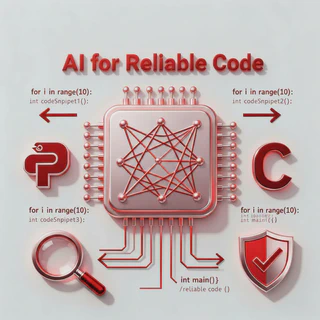Artificial Intelligence for Reliable Code
 Image credit: Perplexity AI
Image credit: Perplexity AIUnderstanding the reasoning and robustness of AI systems, such as Large Language Models (LLMs), is critical for ensuring their reliable use in programming tasks.
While recent studies have assessed LLMs’ ability to predict program outputs, most focus solely on accuracy, without evaluating the reasoning behind those predictions. Moreover, research on the reasoning of these models has shown that LLMs can often arrive at correct answers through flawed logic, raising concerns about similar issues in code understanding.
Developing Artificial Intelligence for Reliable Code requires bridging the gap between statistical learning and formal reasoning. This research explores how Large Language Models (LLMs) can be guided and evaluated to ensure their decisions in programming contexts are logical, interpretable, and verifiable. Our work spans three complementary directions:
- analysing the reasoning capabilities of LLMs in understanding code,
- developing formal verification frameworks for Python using LLMs, and
- integrating fault localisation and program synthesis to enable LLM-assisted automated program repair.
Together, these efforts aim to build the foundations of trustworthy AI for software engineering, models that not only generate correct code but can also explain, verify, and repair it with formal rigour.
🔍 Evaluating LLM Reasoning in Code Understanding
In this project, we first conducted a study to evaluate whether state-of-the-art LLMs (up to 8B parameters) can reason about Python programs or are merely guessing.
We applied five semantics-preserving code mutations:
- variable renaming,
- mirroring comparison expressions,
- swapping if–else branches,
- converting
forloops towhile, and - loop unrolling.
These transformations preserve program semantics while altering syntax.
We evaluated six LLMs and performed a human expert analysis using LiveCodeBench to determine whether correct predictions stemmed from sound reasoning. Additionally, we assessed prediction stability under code mutations using both LiveCodeBench and CruxEval.
Our findings show that LLMs trained for code often produce correct predictions through flawed reasoning in 10–50% of cases. Furthermore, many models changed their predictions across equivalent code versions, indicating a lack of semantically grounded reasoning.
Based on these insights, we argue that current evaluation paradigms for LLMs in code understanding, focused primarily on accuracy, are not fit for purpose. Progress in this field requires shifting toward neuro-symbolic frameworks that prioritise transparent reasoning and formal semantic guarantees.
🧩 PyVeritas 🐍: Formal Verification for Python via LLMs
Python has become the dominant language for general-purpose programming, yet it still lacks robust tools for formal verification. In contrast, languages such as C benefit from mature model checkers, like CBMC, that enable exhaustive symbolic reasoning and fault localisation.
However, the semantic complexity of Python and the verbosity of existing transpilers (e.g., Cython) have historically limited the applicability of such verification techniques to Python programs.
To address this gap, we developed PyVeritas, which is a novel framework that leverages Large Language Models (LLMs) for high-level transpilation from Python to C, followed by bounded model checking, using CBMC, and MaxSAT-based fault localisation, using CFaults, on the generated C code.
The following figure illustrates the PyVeritas verification pipeline:

The goal of PyVeritas is to bridge the gap in formal verification for Python, providing an effective verification pipeline while a robust native model checker for the language is still lacking.
PyVeritas operates by translating Python programs into C code using LLM-based transpilation, then leveraging mature C verification infrastructure to perform symbolic analysis and fault localisation.
Given a Python program and its specification, PyVeritas returns either a formal correctness or failure verdict, or a set of localised buggy statements mapped back to the original Python source.
In this way, PyVeritas enables formal verification and bug localisation for Python code using existing model-checking tools for C.
Our empirical evaluation on two Python benchmarks shows that LLM-based transpilation can achieve 80–90% accuracy for some models, enabling an effective environment that supports assertion-based verification and interpretable fault diagnosis for small yet non-trivial Python programs.
🔧 Guiding LLMs for Automated Program Repair
To further advance the reliability of AI-assisted programming, we have also explored hybrid approaches that combine formal reasoning with LLM-based synthesis for automated program repair.
In this direction, we integrated CFaults, a MaxSAT-based fault localisation tool, with Large Language Models (LLMs) using a zero-shot learning setup to enhance automated program repair for C programming assignments.
CFaults precisely pinpoints buggy statements in a C program using information from failing test cases. In our framework, the faulty statements identified by CFaults are removed, creating a program sketch that is then passed to the LLM.
The LLM is asked to synthesise replacements for the missing code, which are validated against a test suite. If the synthesis fails, a counterexample from the test suite is fed back to the LLM, guiding the next iteration, following a Counterexample-Guided Inductive Synthesis (CEGIS) loop.
This hybrid approach enables LLMs to repair more programs and generate smaller, more precise fixes, outperforming both purely neural and purely symbolic program repair methods.
By integrating formal fault localisation with adaptive synthesis, this work has demonstrated how formal verification and machine learning can complement each other to achieve more reliable and interpretable software repair.
Together, these efforts aim to bridge the gap between AI-driven code generation and formal verification, paving the way for more transparent, reliable, and trustworthy programming AI systems.
References
Pedro Orvalho, and Marta Kwiatkowska (2025). Are Large Language Models Robust in Understanding Code Against Semantics-Preserving Mutations?. In arXiv 2025.
- (2026). PyVeritas: On Verifying Python via LLM-Based Transpilation and Bounded Model Checking for C. In P-AI-FM @ AAAI 2026.
I am always excited to explore new ideas together! Feel free to reach out 📧 if you are interested in collaborating on this research topic!